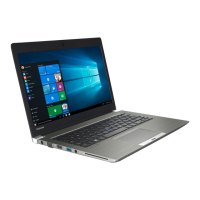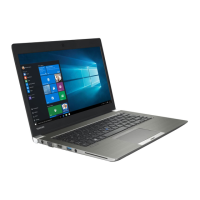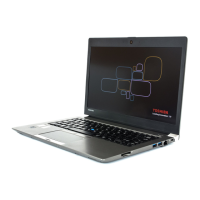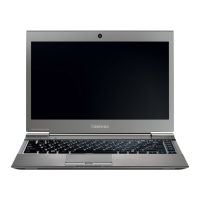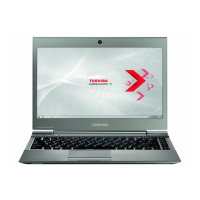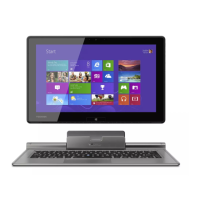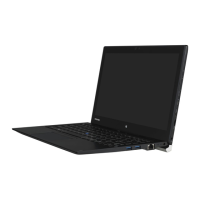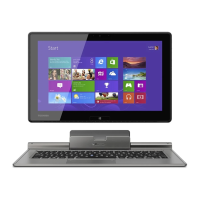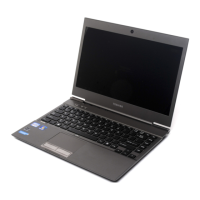
Do you have a question about the Toshiba PORTEGE Z30t-C and is the answer not in the manual?
General safety precautions for using Toshiba computers.
Guidelines for ensuring proper ventilation to prevent overheating.
Instructions and precautions for cleaning the computer.
Guidelines for safely moving the computer.
Lists necessary hardware and documentation components.
Provides basic steps for initial computer setup and use.
Detailed instructions on connecting the AC adaptor and power cord.
Instructions on how to open the computer's display panel.
Steps for powering on the computer for the first time.
Guidance on the Windows startup screen and OS installation.
Procedures for shutting down the computer.
Explains the process and considerations for shutting down the computer.
Steps for restarting the computer.
How to activate Sleep Mode.
Introduction to Hibernation Mode.
Instructions on how to manually activate Hibernation Mode.
Information about the hidden recovery partition and creating recovery media.
Step-by-step guide for creating recovery media.
Guide to restoring the system using created recovery media.
How to restore the system using the recovery partition.
Identifies components of the Z30-C model with the display closed.
Identifies ports and indicators on the left side of the Z30-C computer.
Identifies ports and slots on the right side of the Z30-C computer.
Identifies cooling vents on the back of the Z30-C computer.
Identifies cooling vents and docking port on the underside of the Z30-C computer.
Shows the front of the Z30-C with the display open.
Identifies components of the Z40-C model with the display closed.
Identifies ports and indicators on the left side of the Z40-C computer.
Identifies ports and slots on the right side of the Z40-C computer.
Identifies cooling vents on the back of the Z40-C computer.
Identifies cooling vents and docking port on the underside of the Z40-C computer.
Shows the front of the Z40-C with the display open.
Information about the LCD screen resolution and brightness.
Instructions for powering the computer on/off.
Information on the fingerprint sensor for authentication.
Describes the internal hardware components of the computer.
Information about the internal battery pack and its replacement.
Describes basic touch screen gestures and operations.
Explains various gestures for using the Touch Pad.
Overview of keyboard layout, keys, and indicators.
How to enroll and use fingerprints for authentication.
Information on charging the computer's batteries.
Tips to extend the computer's battery life.
Step-by-step guide for installing a SIM card.
Information about connecting to a Local Area Network.
Step-by-step guide for connecting a LAN cable.
Step-by-step guide for inserting memory media.
Instructions for safely removing memory media.
Steps for inserting a Smart Card.
Instructions for removing a Smart Card.
Steps for connecting an external display.
Connecting an external analog monitor via RGB port.
Connecting external display devices via HDMI port.
Steps for connecting the security lock cable.
Using TOSHIBA Settings for computer configuration.
Enabling Sleep and Charge for external USB devices.
Setting up user and supervisor passwords for computer access.
Steps for setting and managing user passwords.
Procedure for entering the password when starting the computer.
Accessing BIOS setup utility for changing settings.
Using Maintenance Utility to erase the internal storage drive.
Turning off power without exiting software.
Turning off power without exiting software, saving to storage.
Guidelines for effectively resolving computer problems.
Questions to ask to identify the cause of a computer malfunction.
Addresses issues like unresponsiveness and program freezes.
Troubleshooting steps when the computer fails to power on.
Troubleshooting automatic shutdowns due to overheating.
Troubleshooting AC power issues, including adaptor problems.
Troubleshooting battery-related issues.
Troubleshooting the computer not powering on.
Troubleshooting keyboard issues, such as garbled output.
Troubleshooting Touch Pad not working or sensitivity issues.
Information on how to get additional help from TOSHIBA.
Information on TOSHIBA's technical support website.
Steps to disable the Intel AMT function.
